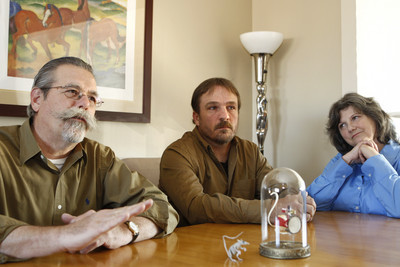Las Vegans had hand in ambience of ‘Coraline’
It took more than two years to make the new stop-motion animated feature "Coraline," which opens in theaters today.
And three Las Vegans who worked on the production assume you won't notice their efforts at all.
Lee "Bo" Henry managed construction of "Coraline's" extensive, exquisitely detailed sets (150 of them), while lead scenic artist Linda Overbey and her husband, set painter Chris Lloyd, helped bring those sets to life in painstaking, delicate detail.
The sets provide a fanciful backdrop for Neil Gaiman's tale of a feisty girl who discovers a strange alternate reality behind a tiny door in her family's new apartment -- which is really part of an old Victorian abode.
"You spend months creating something to have it go away," Henry says. "If your sets are really good, people won't even notice."
Even Overbey admits she got caught up in the magic of the story rather than paying attention to her own contributions to the movie.
"I found myself watching the characters, too," she says. "We create the ambience. If it wasn't good, you'd notice it."
Creating that ambience took more than two years, in an Oregon animation studio owned by Nike co-founder Phil Knight -- whose son, Travis Knight, is one of "Coraline's" lead animators.
But director Henry Selick -- whom Henry first worked with in the late '80s -- spent five years developing, adapting, producing and directing "Coraline."
Henry and Overbey each worked more than two years on the movie; Lloyd joined the crew about a year into the production.
And while both Henry and Overbey had worked with Selick previously (notably on 1993's "The Nightmare Before Christmas," which he directed), "Coraline" was Lloyd's introduction to stop-motion animation.
With experience painting everything from houses to Disney's California Adventure theme park, Lloyd "had done a lot of different paint work" before making his movie debut, he notes. "I wasn't even sure how much I could help them."
But it turned out that a lot of work that needed to be done, from sanding to spackling, was "stuff I just loved to do," he says. "It was wonderful."
Although the movie's 150 sets were built to one-sixth scale -- life-size for "Coraline's" puppet characters -- some of them proved extensive indeed.
The movie's orchard set, for example, was 60 feet long, Henry notes, and included 60 trees -- each one of which took eight to 12 hours to make.
Some scenes that took two weeks to shoot have less than a minute of screen time in the finished production.
And before the camera could capture any scenes, Overbey and her colleagues had to solve a variety of problems, from finding a wallpaper glue that could last for the entire production schedule to smoothing out a paint finish on a model car.
During production, crew members watched just-filmed footage "in a loop" every morning, Henry recalls. "We were looking for all the nuance, small little details, whether something needs to have an enhanced shadow -- or does something need to be moved or tweaked?"
All that detail, all that trouble-shooting, "the tininess of things people had to paint," Overbey muses. "That's the fun of it, really -- fixing it, making it look seamless."
Not that anyone will notice, of course.
Except, perhaps, the "animation nerds out there" who pay close attention to such things, she says. "The general public won't."
At least that's what she and her "Coraline" colleagues hope.
Contact movie critic Carol Cling at ccling@reviewjournal.com or 702-383-0272.
RELATED STORY MOVIE REVIEW: 'Coraline'















